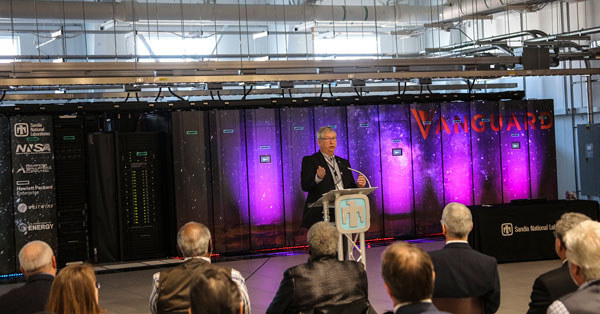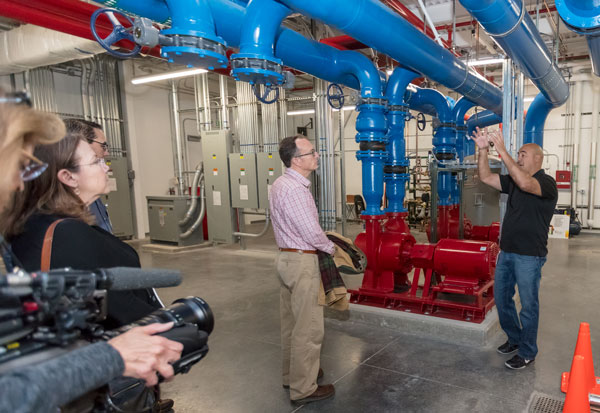
COLORFUL MACHINE — Senior manager Ken Alvin describes Sandia’s Vanguard program and the Astra machine. (Photo by Lonnie Anderson)
On Nov. 28, Sandia’s new Astra supercomputer stood bathed in violet and blue-green lights inside a newly built white-walled building with a 30-foot-high ceiling — long and wide enough to house a basketball game and a crowd of spectators.
About 200 Sandia staff and visitors sat on chairs or stood to watch the ceremonial cutting of a foot-wide golden ribbon to celebrate the formal opening of the facility and, unofficially, the first-of-its-kind supercomputer it houses.
“It may not be the fastest computer in the world, but it’s probably the most attractive,” joked deputy Labs director Dave Douglass as he examined the computer’s lighting and surface art. Dave also remembered “standing with a shovel on a cold and rainy day,” when he took part in the groundbreaking for the building last year.
The building, LEED gold-certified, was designed and built in 18 months at an estimated cost roughly half that of renovating an older building. The Leadership in Energy and Environmental Design rating system is the most widely recognized rating system for highly efficient, environmentally responsible green buildings.
In addition, award-winning thermosyphon work led by “visionary engineer David Martinez” is expected to save several million gallons of water normally needed for supercomputer cooling, said senior manager Tom Klitsner.
The supercomputer, the first ever built of Arm microprocessors with the intent of broadening the supplier base for future computers, was assembled in a month, but still placed 36th in the global TOP500 High Performance Gradients Conjugate test that Sandia helped design. It achieved that performance despite the fact that a quarter of its processors had not yet been installed at the time of the test.
Most powerful Sandia machine ever
Its theoretical peak of 2.3 petaflops makes it the most powerful supercomputer ever installed at Sandia.
Host and director Scott Collis described the extraordinary lineage of computing at Sandia, beginning with the Paragon, the world’s first parallel processing computer to lead the bi-annual Top500 list in speed; recipient of the inaugural Gordon Bell Prize; the design and installation of ASCI Red, the world’s first teraflop computer; and Red Storm, a computer whose design became a mainstay of Cray Inc.
This history has continued more recently in close partnership with Los Alamos National Laboratory, with the Cielo and Trinity supercomputers, each tracing their lineage to Red Storm, Scott said.

Senior manager Ken Alvin described the intent of the project to “accelerate across the gap of experimental to production technology” under Sandia’s Vanguard program, which invests relatively small amounts of money in new technologies to see if they work out, rather than betting the farm by investing heavily on every new approach.
Astra is the first of this experimental line, and its success may mean more, and larger, supercomputers using the Arm technology in the future. Arm processors previously had been used exclusively for low-power mobile computers, including cell phones and tablets. A single Astra node is roughly one hundred times faster than a modern Arm-based cell phone, and Astra has 2,592 nodes.
Astra project lead James Laros, described by Ken as the man “who more than anyone is responsible for the machine being here today,” recounted the thrill of getting the computer up and running in so short a time.
“Challenges for technical people are why people come to work at national laboratories,” James said.
Additional pictures and statistics on the building can be found in the HPC Annual Reports.